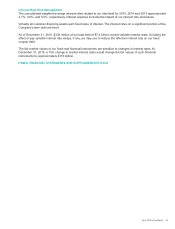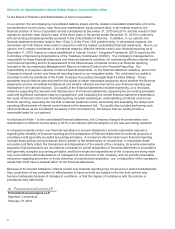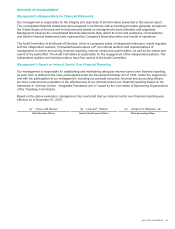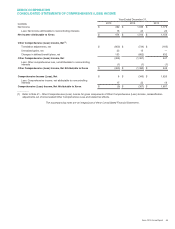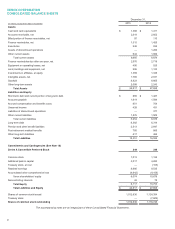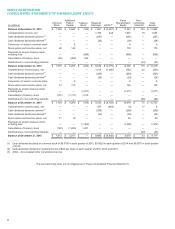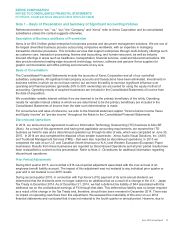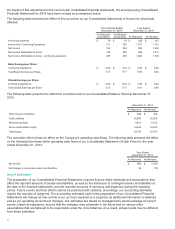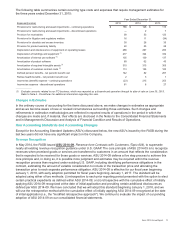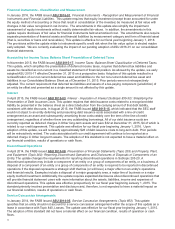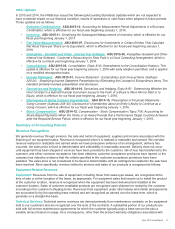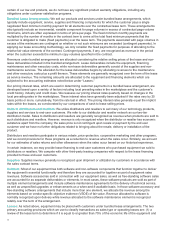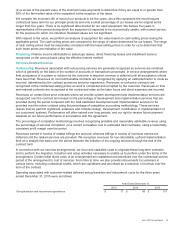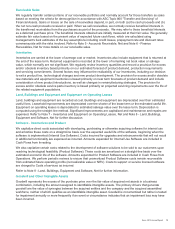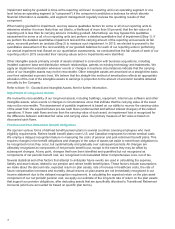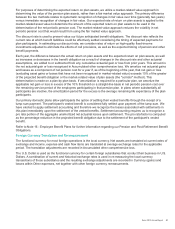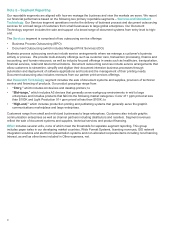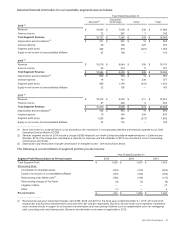Xerox 2015 Annual Report Download - page 89
Download and view the complete annual report
Please find page 89 of the 2015 Xerox annual report below. You can navigate through the pages in the report by either clicking on the pages listed below, or by using the keyword search tool below to find specific information within the annual report.
The following table summarizes certain recurring type costs and expenses that require management estimates for
the three years ended December 31, 2015:
Year Ended December 31,
Expense/(Income) 2015 2014 2013
Provisions for restructuring and asset impairments - continuing operations $ 186 $128 $115
Provisions for restructuring and asset impairments - discontinued operations — 27
Provision for receivables 58 53 123
Provisions for litigation and regulatory matters 16 11 (34)
Provisions for obsolete and excess inventory 30 26 35
Provision for product warranty liability 22 25 28
Depreciation and obsolescence of equipment on operating leases 286 297 283
Depreciation of buildings and equipment (1) 277 324 332
Amortization of internal use software (1) 135 139 137
Amortization of product software 69 62 43
Amortization of acquired intangible assets (1) 310 315 305
Amortization of customer contract costs (1) 113 128 100
Defined pension benefits - net periodic benefit cost 142 82 267
Retiree health benefits - net periodic benefit cost 2 31
Income tax (benefit) expense - continuing operations (23)215 253
Income tax expense - discontinued operations 81 627
__________________
(1) Excludes amounts related to our ITO business, which was reported as a discontinued operation through its date of sale on June 30, 2015.
Refer to Note 4 - Divestitures for additional information regarding this sale.
Changes in Estimates
In the ordinary course of accounting for the items discussed above, we make changes in estimates as appropriate
and as we become aware of new or revised circumstances surrounding those estimates. Such changes and
refinements in estimation methodologies are reflected in reported results of operations in the period in which the
changes are made and, if material, their effects are disclosed in the Notes to the Consolidated Financial Statements
and in Management's Discussion and Analysis of Financial Condition and Results of Operations.
New Accounting Standards and Accounting Changes
Except for the Accounting Standard Updates (ASU's) discussed below, the new ASU's issued by the FASB during the
last two years did not have any significant impact on the Company.
Revenue Recognition
In May 2014, the FASB issued ASU 2014-09, Revenue from Contracts with Customers (Topic 606), to supersede
nearly all existing revenue recognition guidance under U.S. GAAP. The core principle of ASU 2014-09 is to recognize
revenues when promised goods or services are transferred to customers in an amount that reflects the consideration
that is expected to be received for those goods or services. ASU 2014-09 defines a five step process to achieve this
core principle and, in doing so, it is possible more judgment and estimates may be required within the revenue
recognition process than required under existing U.S. GAAP, including identifying performance obligations in the
contract, estimating the amount of variable consideration to include in the transaction price and allocating the
transaction price to each separate performance obligation. ASU 2014-09 is effective for our fiscal year beginning
January 1, 2018, with early adoption permitted for fiscal years beginning January 1, 2017. The standard will be
adopted using either of two methods: (i) retrospective to each prior reporting period presented with the option to elect
certain practical expedients as defined within ASU 2014-09; or (ii) retrospective with the cumulative effect of initially
applying ASU 2014-09 recognized at the date of initial application and providing certain additional disclosures as
defined per ASU 2014-09. We have concluded that we will adopt this standard beginning January 1, 2018, and we
will use the retrospective method with the cumulative effect of initially applying ASU 2014-09 recognized at the date
of initial application (i.e., the "modified retrospective approach"). We continue to evaluate the impact of our pending
adoption of ASU 2014-09 on our consolidated financial statements.
Xerox 2015 Annual Report 72


